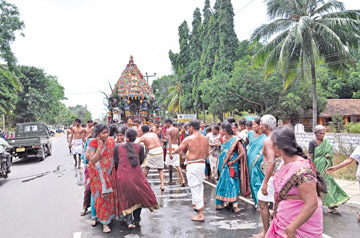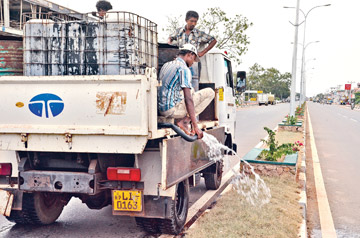|
Development:
Democracy restored :
Sustained economic growth in North ensures peace, development
by Dhaneshi Yatawara
Ever since Sri Lanka Army's Operation Jayasikuru, the LTTE's nerve
centre had been Kilinochchi. The fall of Kilinochchi out of the hands of
the terrorists, on January 2, 2009, was a turning point in Sri Lanka's
battle against terrorism.
 |
| A true moment
of heartfelt peace and harmony in the Wanni |
 |
| Kilinochchi
today |
 |
| Oddusudan
today |
 |
| The
Vadduvakkal lagoon and causeway soon after being cleared in 2009 |
During the intense battle, the Army had no time to pause and the
terrorists held on to Kilinochchi, their nerve centre, with all their
might. The Sri Lanka Army's 57 Division, commanded by Major General
Jagath Dias, was determined to liberate Kilinochchi, realising that
their victory would lead the entire Wanni region out of terrorism.
When the troops passed the Thunukkai and Mallavi towns in August and
September 2008 respectively, it showed that the soldiers were determined
to reach Kilinochchi. The LTTE held Kilinochchi with their first bunker
line and security concentrations at Iranamadu tank, Thirumurukandy
junction and the Akkarayankulam road. An ‘L’ shaped bund stood beyond
this point.
Led by Maj. Gen. Dias, the troops did not pause after liberating
Thunukkai and Mallavi and it was this momentum that left no room for the
LTTE to fortify themselves. Many soldiers laid down their lives. The
LTTE was constructing a new defence line and Sri Lanka Army troops,
without allowing them to complete it, crossed the line at great cost to
their lives. As Maj. Gen. Dias explained then, during the ‘fire’, a
totally different tactic was adopted. It was an equilibrium between
offensive and defensive tactics that the Army had to perform in a short
span of time.
In military terms, the Army ‘assaulted in depth'. When soldiers
captured a point, another group of soldiers would pass their own team
and spear ahead, leaving no time for the LTTE to attack. The Division
faced all possible difficulties as well as adverse weather conditions,
also tackling ‘impossible to evacuate’ casualties.
Three assaults
The 57 Division launched three assaults on the LTTE defence line and
on the fourth, they managed to capture it. This became possible thanks
to an eight-man team from the Gajaba infantry which went on a recce
(reconnaissance) mission to see the enemy terrain during the wee hours
of January 1, 2009.
They went up to the Kilinochchi railway station and found that the
LTTE had abandoned Kilinochchi and withdrawn to Dharmapuram. The
artillery attacks had been to facilitate their withdrawal. Based on
communications back to their tactical headquarters, troops of 9 GR
carried out the final assault. By January 2, the 57 Division troops had
liberated Kilinochchi.
They didn't stop there. With the 58 Division, commanded by Maj. Gen.
Shavendra Silva operating on to the North of the 57 Division, the joint
force started moving towards the Eastern Coast. The 57 Division
re-organised with the 58 Division, task force 3 and 4 and balance troops
in the South, heading towards Vishwamadu and Dharmapuram, enabling the
first batches of civilians to escape the LTTE's iron clutches.
Today, people, not only Hindus, but all travellers to the North get
down at the Thirimurukandi junction, worship at the Hindu temple,
seeking blessings for a safe journey. Hardly anyone seem to remember the
lives of the soldiers sacrificed to protect that plot of land. No one
knows the cries of pain of those young men who suffered fatal wounds and
were unable to be evacuated.
It was just a fraction of the drama. Following the military victory,
clearing the territory which had been held by the LTTE for nearly three
decades and the implementation of the master plan for the immediate
resettlement and rehabilitation of the Northern people was another major
battle. One of the main elements of this master plan was a 180-day
program to facilitate immediate resettlement. Having accommodated the
displaced people in the welfare centres for the time being, the most
difficult task became making immediate arrangements to resettle them in
their places of origin.
President Mahinda Rajapaksa appointed a Presidential Task Force for
Resettlement, Development and Security in the Northern Province under
Senior Minister Basil Rajapaksa to immediately work out a program for
rapid resettlement and reconstruction of the Northern Province. The
mission given to the Task Force was to formulate a strategic framework
for revitalising the Northern Province and implement the rapid
resettlement program.
Presidential Task Force
According to S.B. Divarathne of the Presidential Task Force for
Resettlement, Development and Security in the Northern Province, the
resettlement process that was adopted in Sri Lanka was not ad hoc; it
was well planned and well focused and worked through proper policies.
The resettlement policy envisaged that the resettlement process was
voluntary and not forced; that the displaced people should be resettled
in their original places of habitation; and that the process should be
dignified and safe in terms of the International Humanitarian Law.
The objectives of the 180-day program was to identify the priorities
through well-coordinated plans, enlisting the support of line ministries
and all external agencies, the UN system and INGOs working at the time
in Sri Lanka, to create a conducive environment before resettlement took
place, then plan out the different phases of resettlement.
What were the challenges that had to be faced in this process of
resettlement? First was de-mining, second the restoration of basic
facilities, as Divarathne explained.
“One of the most difficult tasks was de-mining and one of the
constraints we faced was the lack of machines for de-mining. So the
Government had to embark on the procurement of equipment from other
countries at a huge cost and we had to airlift them; 19 such machines
had to be airlifted to carry out the de-mining process as quickly as
possible.”
Basic infrastructure
To restore the basic infrastructure, the Presidential Task Force had
to appoint separate teams to assess the damage and also find the
required funds to carry out the restorations of basic facilities. There
again, the problem was the lack of heavy machinery. Sri Lanka had to
import a large volume of machinery from China.
The Government's aim was to develop an economic base for the
displaced people from the inception of the resettlement program, with
the hope of enhancing livelihood activities that would enable them to
put up houses.
The next phase of this program was the early recovery that was to
provide them assistance to recommence their economic activities.
“We gave them many facilities particularly for agriculture, home
gardening, inland and lagoon fishing and various other support services
for them to immediately start paddy cultivation. In the Northern
Province, the main source of livelihood of the people is paddy
cultivation; there are about 180,000 acres of cultivable paddy land,
which were not cultivated and were abandoned,” he said.
Having completed that, the other element of the resettlement process
was the reconstruction of infrastructure. The Government, up to now, has
committed nearly three billion US dollars for this purpose, which
includes investments on roads, railways, the supply of electricity and
water, and other economic and social infrastructure. The Northern
Province had just emerged from devastation with the desire of being
transformed into a region of hope and regeneration.
The massive public investment made on those two provinces in the past
four years would have been adequate to finance 15 Colombo – Katunayake
Expressways, four Colombo - Galle Expressways, 93,500-bed hospitals,
2,870 1,000-student schools, eight South Colombo breakwaters, 14
international airports and seven power plants generating 300MW,
according to Governor, Central Bank of Sri Lanka, Ajith Nivard Cabraal.
He said this at the 2013 Defence Seminar held earlier this month in
Colombo.
Economic prospects
“At the same time, the violence and terror in the North and the East
materially dampened economic prospects since the early 1980s with the
momentum of economic growth slowing down. Investment in infrastructure
was diverted to military expenditure and priority was given to the
uncertain security situation. The economy always took second place and
the sentiments were unfavourable and gloomy. There was difficulty in
maintaining investor confidence in the midst of uncertainty. Since 1983,
the entire country faced the acute impact and burden of terrorism and
there were productivity losses and under-utilisation of production
capacity,” Cabraal said.
“During the last four years, Sri Lanka's economy has been on the
average of an impressive 7.5 percent. We had been consistently reporting
a high growth in a space of time where worldwide, there was really tough
going,” he said. As he explained, “With all these expenses, we as a
country have been able to maintain macro-fundamentals in a benign
category, particularly inflation”. Though the overall effect is
difficult to quantify, the reduction in economic growth of the country
due to terrorism has been estimated at around one to two percent
annually. “Rapid growth since then in the affected provinces supported
the country’s overall growth momentum. In fact, since 2009, the affected
regions have shown promise with a high growth path.”
Overall, from 2009 to 2013, public investment in the North and the
East amounts to three billion US dollars. Such sustained improvement in
economic performance, despite the uncertain global economic environment,
has ensured continued peace and development, which today has led to the
establishment of democracy with the free will of the people. |

